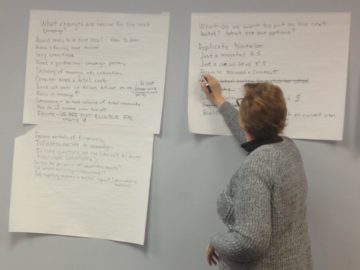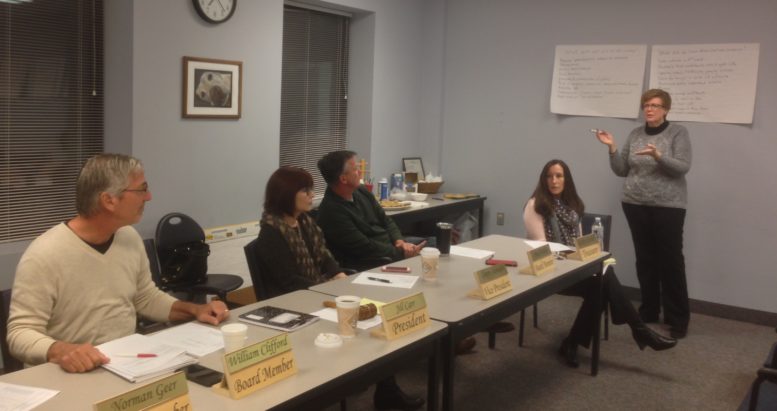By DAVID DUPONT
BG Independent News
Back in November when the Bowling Green school bond issue went down in defeat, board members insisted that they would return with the same $72 million plan that would consolidate the district’s three elementary schools and extensively renovate and expand the high school.
Early Monday morning, two months later, they met to discuss whether that was the best option. The workshop session was part post mortem of the election and part a free-wheeling discussion about what other options there may be to address the district’s building needs.
In the end, the board seemed poised to return to the ballot, possibly as early as May, with the same plan.

Board President Jill Carr writes down ideas during brainstorming session.
The board, which meets in regular session Tuesday, set another special meeting for Friday, Jan. 19 at 7:30 a.m. to further discuss the next step. It is possible a decision on whether and what to put on the ballot and when will be determined then. They must decide by Jan. 31 if the board is to put the issue on the May ballot.
Board member William Clifford, who said on election night that the board would return with the same plan, asked Monday whether there was any way to trim the cost of the project. His fear, he said, was that coming back with the same amount would tell the voters they weren’t being listened to.
“We weren’t asking for any more than we needed,” board member Ginny Stewart said. “We were so far behind we needed to catch up.”
Norm Geer, who was elected to the board in November, said that those who voted against the levy weren’t “anti-education.” Many factors were at play, including the loss of neighborhood schools as well as the cost.
“We have to convince people it’s money well spent,” he said. “It’s money that can save money in the future.”
Superintendent Francis Scruci said that consolidating the elementary schools would save the district $100,000 a year in transportation costs, and eliminate three routes. That would mean the district would not have to buy as many buses. The new elementary would allow the district to bring some programs back into district property and save on rentals and the expense of having those students educated out of the district. The plan would be to move the central office, now in rental space downtown, into Crim Elementary.
As it stands, Crim has a space crunch, Scruci said. Installing a modular classroom there would cost about $200,000, almost twice what it costs at Conneaut because Crim lacks the necessary utility hookups.
The consolidation also would also have educational benefits by allowing teachers to collaborate more closely, he said. This would help the district continued the improvements it is making, such as the increase in third grade reading scores.
That could be achieved by turning the three elementary schools into grade level buildings with all the students from a specific grade going to the same school – K-1 in one school, grades 2-3 in another, and grades 4-5 in the third. That arrangement, however, would greatly increase transportation costs.
The consolidated elementary building, he said, was designed with the future in mind. There are currently as many as 10 classes per grade level. The new building will have room for 12.
Board member Paul Walker noted that interest rates are increasing as are construction costs, so the price of the project will only increase over time.
Scruci also said the recent property revaluation has increased the value of property in the district by about $40 million to about $667 million. That change is enough to drop the millage for the project from 6 mills to 5.69 mills, Treasurer Cathy Schuller said.
Still those kind of details tended to get lost in the election campaign. Some voters, Scruci said, don’t understand that what their home’s assessed value for tax purposes is lower than its value.
Also, people continued to contend the district should apply for state money. Scruci said the district is not eligible for state money. Because of its perceived wealth Bowling Green is ranked toward the bottom of the list of schools in terms of need for funds.
The board was frustrated that the levy failed in in Ward 3. Overall the levy passed in the city, but was opposed by 69 to 90 percent in the rural precincts.
Board president Jill Carr said she’d heard frustration that the university faculty and staff did not back the levy as strongly as expected.
If the board chooses to go back to the ballot it has three options – May, August, and November. If it went in August, it would be a special election, and the board would have to pay the $25,000 to $30,000 cost of running that election.
Scruci indicated he feels the larger the turnout, the better the levy’s chances of winning are.
An informal poll of the board had four members supporting staying the course. Only Clifford expressed some hesitance about that strategy.




